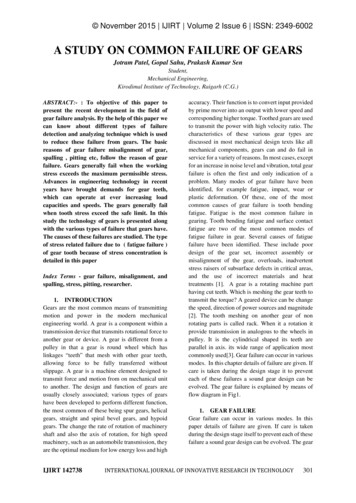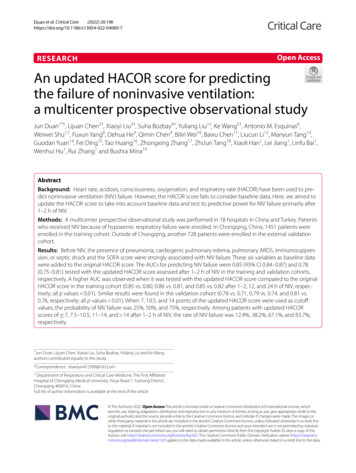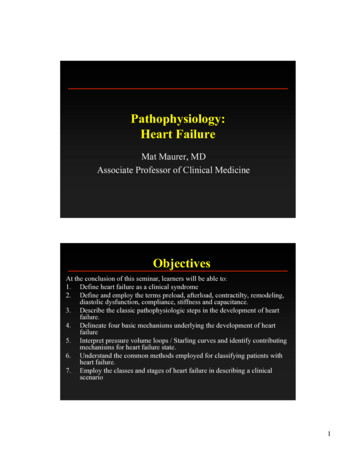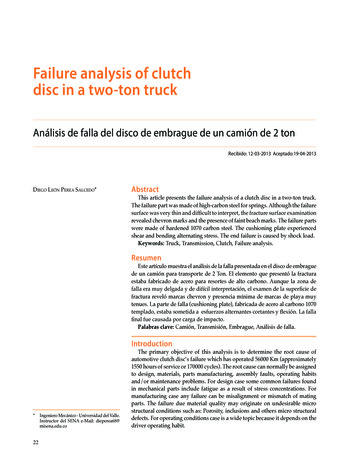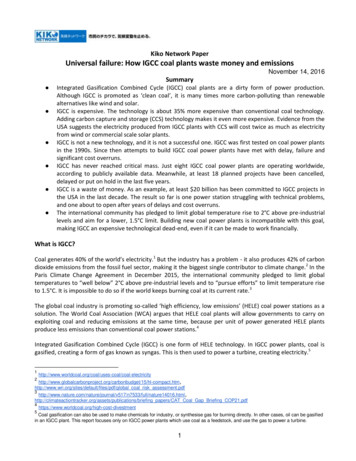
Transcription
Kiko Network PaperUniversal failure: How IGCC coal plants waste money and emissionsNovember 14, 2016Summary Integrated Gasification Combined Cycle (IGCC) coal plants are a dirty form of power production.Although IGCC is promoted as ‘clean coal’, it is many times more carbon-polluting than renewablealternatives like wind and solar.IGCC is expensive. The technology is about 35% more expensive than conventional coal technology.Adding carbon capture and storage (CCS) technology makes it even more expensive. Evidence from theUSA suggests the electricity produced from IGCC plants with CCS will cost twice as much as electricityfrom wind or commercial scale solar plants.IGCC is not a new technology, and it is not a successful one. IGCC was first tested on coal power plantsin the 1990s. Since then attempts to build IGCC coal power plants have met with delay, failure andsignificant cost overruns.IGCC has never reached critical mass. Just eight IGCC coal power plants are operating worldwide,according to publicly available data. Meanwhile, at least 18 planned projects have been cancelled,delayed or put on hold in the last five years.IGCC is a waste of money. As an example, at least 20 billion has been committed to IGCC projects inthe USA in the last decade. The result so far is one power station struggling with technical problems,and one about to open after years of delays and cost overruns.The international community has pledged to limit global temperature rise to 2 C above pre-industriallevels and aim for a lower, 1.5 C limit. Building new coal power plants is incompatible with this goal,making IGCC an expensive technological dead-end, even if it can be made to work financially.What is IGCC?Coal generates 40% of the world’s electricity.1 But the industry has a problem - it also produces 42% of carbondioxide emissions from the fossil fuel sector, making it the biggest single contributor to climate change.2 In theParis Climate Change Agreement in December 2015, the international community pledged to limit globaltemperatures to “well below” 2 C above pre-industrial levels and to “pursue efforts” to limit temperature riseto 1.5 C. It is impossible to do so if the world keeps burning coal at its current rate.3The global coal industry is promoting so-called ‘high efficiency, low emissions’ (HELE) coal power stations as asolution. The World Coal Association (WCA) argues that HELE coal plants will allow governments to carry onexploiting coal and reducing emissions at the same time, because per unit of power generated HELE plantsproduce less emissions than conventional coal power stations.4Integrated Gasification Combined Cycle (IGCC) is one form of HELE technology. In IGCC power plants, coal isgasified, creating a form of gas known as syngas. This is then used to power a turbine, creating i.org/sites/default/files/pdf/global coal risk ctiontracker.org/assets/publications/briefing papers/CAT Coal Gap Briefing stment5Coal gasification can also be used to make chemicals for industry, or synthesise gas for burning directly. In other cases, oil can be gasifiedin an IGCC plant. This report focuses only on IGCC power plants which use coal as a feedstock, and use the gas to power a turbine.1
IGCC is a more efficient way of generating power than burning the coal directly, and therefore less polluting.6 Astandard coal plant converts up to 38% of the coal’s energy to power, according to international data.7 IGCCtechnology can raise this figure to 45 - 50%.8 Overall, IGCC plants emit around 20% less carbon dioxide thanconventional coal plants, according to Japanese industry data.9But IGCC has several disadvantages which have limited its take up. First, it is expensive. The US EnergyInformation Administration estimates that an IGCC coal plant costs around 4.4 billion per gigawatt of capacityto build, making it about 35% more costly than a conventional coal plant.10Secondly, IGCC plants are complicated and difficult to build, and getting plants to operate successfully has notproven easy. As a result many new-build IGCC plants have experienced technical problems.11Thirdly, even though IGCC coal plants are more efficient than conventional coal plants, they are still highlypolluting. Conventional coal is about twice as carbon-polluting as gas power stations and at least ten times aspolluting as renewable sources like wind and solar power.12 Reducing coal’s emissions by an additional 20% willhave a limited impact on these figures.IGCC and carbon emissionsNew coal could single-handedly ruin our chances of meeting the 2 C target. 1,400 GW of new coal capacity iscurrently planned, permitted or under construction globally. If all of these plants are built it would beimpossible to limit temperature rise to 2 C, even if all other emissions from generating electricity fell to zero.13This is true even if all the new coal plants were all built to the highest HELE standards. In other words, even ifevery single planned coal power plant used IGCC technology, new coal would still tip the world into dangerousclimate change.Carbon capture and storage (CCS) technology could theoretically be used to reduce emissions further. IGCCplants are described as ‘capture ready’, because the technology makes it easier to attach CCS to an IGCC plantthan a conventional power plant.14If every new coal plant used both the most efficient HELE technology and CCS, global temperature rise couldfeasibly be limited to 2 C.15 But this is a highly unlikely scenario. Attempts to develop IGCC/CCS plants gasification, rGenerationWEB Updated March2013.pdf, gy/gtcc pdf tp://www.iea.org/media/etp/etp2012 tech overview 01 ittee/kenkyukai/energy environment/jisedai karyoku/pdf/003 03 00.pdf, ,http://www.hitachi.com/rev/pdf/2013/r2013 01 105.pdf10111213142013 figures ament.uk/briefing-papers/POST-PN-253.pdfCited in http://www.ucsusa.org/clean /CO2 Capture Ready Plants.pdf2
particular have proved to be very expensive projects, beset with difficulties. One recent assessment of thefeasibility of a proposed IGCC/CCS plant in Australia concluded that “Industrial–scale, low emissions coal–firedpower projects incorporating CCS are not currently economic’”.16 Evidence from the USA suggests that IGCCwith CCS currently produces electricity at about twice the cost of onshore wind and utility scale solar power.17IGCC: A stalled technologyIGCC isn’t a new technology. It was developed in the 1960s and the first test coal plants using IGCC came onlinemore than two decades ago, in the 1990s.18Over the years, IGCC has been endorsed by a range of governments and commentators. It has been describedas the “last chance for coal”19 or “cleaner coal’s last stand”.20 In the 2000’s IGCC was supposed to provide anew wave of coal plants in the UK.21 As recently as 2013, the US Energy Secretary said of IGCC coal plants:“We’re going to need maybe 100 more of these projects”.22Despite such enthusiasm, only a handful of IGCC plants have been built.23 There are currently only eight activeIGCC coal plants worldwide and one about the start commercial operation, according to data from Coalswarm,the US Department of Energy and other publicly available sources.24 Three of those were constructed in the1990s. Only five started operating in the last ten years - two in China, one in South Korea, one in the USA andone in Japan.25The International Energy Agency (IEA) says “a large number of IGCC projects have been announced, offered forsale, then failed to proceed”.26 At least 18 planned IGCC plants have been cancelled, shelved or put on holdglobally in the last five years alone, according to publicly available data.27There are at least 20 projects in preparation or under construction around the world. In addition there may beabout another ten being scoped in China, on which there is more limited data.28 The financing for some ofthese projects is uncertain, however.29 Globally nearly all IGCC projects “seem to have experienced varyingdegrees of cost overruns, delays and doubts about their /levelized cost of energy - version energy/fossil-fuels/cleaner-coals-last-standSee e.g. 26192029-cleancoal.pdf, /a remarkable ent-of-commercial-IGCC,-CCC/22224See separate spreadsheet. Sources include gasification-database25See separate ment-of-commercialIGCC,-CCC/22227See separate /report 141115/141115 ryuu presentation.pdf p.729See for example http://www.sourcewatch.org/index.php/Galilee Power project, ve-a-future/?printmode 13
Case study: SpainThe Elcogás Puertollano plant in Spain opened in December 1997. The plant was intended to demonstrate theability to convert poor quality coal with a high ash content into a less polluting power source.31 At the time,newspaper articles labelled it a “technological bet for clean coal”.32At around 300MW, Elcogás was the largest IGCC plant in the world to use solid fuel, although still smaller thana typical 500MW coal plant.33 The plant was part-funded by the European Commission.34In its first ten years of operation, Elcogás experienced numerous technical difficulties and more than 6000modifications were made to the plant’s design.35 By July 2014, it had accumulated 190 million Euros of debt,and its operators requested permission to close.36A Spanish government rescue package - proposed on the basis that Elcogás was “environmentally beneficial” was rejected by the European Commission. Independent assessors in Spain also ruled it anti-competitive. Theplant closed for good on 31 January 2016, and the Spanish government does not appear to have plans toencourage any more IGCC coal plants.37Case study: USAExpectations for IGCC technology were higher in the USA than anywhere else in the world. Numerous IGCC coalpower stations were proposed in the early 2000s, but most never passed the planning stages. Between 2007and 2009 alone 14 IGCC projects in the USA were cancelled, according to Coalswarm data, including plants inFlorida, Wyoming and Colorado.38 Many were cancelled when a dramatic fall in gas prices as a result of thebooming shale gas industry made expensive IGCC coal plants even less competitive.39Today, there are only three IGCC plants operating in North America - one of which will shortly be converted toproduction of fertiliser rather than electricity.40 The world’s first commercial scale IGCC plant, in Indiana,started operating in June 2013. The company originally estimated that cost of the plant at around 2 billion.After cost overruns and delays, the cost rose to 3.5 billion. The plant attracted considerable local opposition,and has struggled with technical problems since 826 ciedad/833320829 35https://www.usea.org/sites/default/files/082013 t%20of%20commercial%20IGCC caso-apuesta-renovables 0 9/18/pdfs/BOE-A-2015-10073.pdf, p/Integrated Gasification Combined Cycle (IGCC)http://www.sourcewatch.org/index.php/Polk Power Station Unit 6, http://www.sourcewatch.org/index.php/Buffalo Energy Project,http://www.sourcewatch.org/index.php/Bowie IGCC Power lestone/, ng-with-technical-problems/, er-not-bright-future/ Docketed Cases/ViewDocument.aspx?DocID 0900b6318016d0454
Kemper County, Southern Company’s iconic 580MW plant in Mississippi, has not yet started operation.Proposed as the world’s first large scale IGCC plant with carbon capture and storage (CCS), the cost of the plantwas originally estimated at around 2.2 billion.42 This then rose to an estimated 6.66 billion, making it one ofthe most expensive energy projects ever.43 Earlier this year, Southern Company was accused of deliberatelyhiding the project’s costs in order to protect its access to government subsidies.44 The plant will now open atthe end of November, according to reports45 - three years behind its original schedule.46Another project in Texas - the ‘Texas Clean Energy Project’ (TCEP) located near Odessa - also aims to combineIGCC with CCS technology. Originally planned for completion in June 2014, TCEP is currently still in the planningstages. The projected cost has doubled from about 1.9 billion to 3.9 billion. So far it has cost the US taxpayer 116 million, according to a recent report from the US Department of Energy.47The complicated design of IGCC/CCS plants means these new-build plants have encountered a large number oftechnical problems, increasing their cost and leading to delays. In turn this has discouraged investors, making itmore difficult to access financing.48At least 20 billion of public and private sector money has been committed to IGCC power stations in the USAin the last decade.49 To date this has produced one coal power station struggling with technical problems, andone about to open after years of delays and cost overruns.Case study: ChinaChina is the largest market for coal gasification technologies in the world. China uses coal gasificationtechnology to make chemicals from coal; to generate substitute natural gas, and to generate liquid transportfuels. Despite gasification being a familiar technology, the government’s investment in IGCC technology hasbeen relatively limited. This is probably because it is an expensive way of generating electricity, compared toother methods.50Publicly available data suggests there are currently two IGCC plants using coal to generate electricity in China.One is a ‘polygeneration’ plant, which use the coal gasification process to synthesise chemicals, and generatepower as a minor part of its papub/nepa costs-rise-and-delays-loom-again/, per-coal-mississippi.html? r mag.com/does-igcc-have-a-future/Calculation sheet 3 on separate ductAbstract.aspx?ProductId 00000000300200151151Yankuang Cathay Coal Chemicals Company polygeneration demonstration %20Learning%20Laboratory.pdf p.1105
A 250MW IGCC coal plant known as ‘GreenGen I’ is China’s first full-scale IGCC power plant. Two plannedextensions to the project would make the plant much larger, adding another 800MW of capacity as well as CCStechnology to capture the carbon produced.52 The first extension was originally planned for 2015, butaccording to press coverage has been delayed to 2020. Cost overruns are not publicly known.53Local reports suggest there are about another 10 IGCC power projects being scoped out in China.54 The Chinesegovernment, however, has recently suspended construction of coal-fired power plants in fifteen regions and iscurtailing coal plant approvals in others.55 It seems questionable how many of these will actually be developed.The future of IGCCIGCC coal plants are not expected to form a major part of global growth in coal-fired plants over the next tenyears. ‘Supercritical’ coal plants, which are cheaper than those using IGCC technology, accounted for 50-60% ofso-called ‘clean coal’ installations from 2011 to 2014. In the future, the WCA expects supercritical coal - whichare less efficient than IGCC plants - to continue to dominate.56The WCA does argue, however, that IGCC will see “substantial additions” between 2015 and 2025, particularlyin China and the USA.57 Overall, the WCA sees Asia as the biggest market for clean coal - and manycommentators see the success of planned IGCC plants in Asia as the “last chance” for the technology.58South Korea aims to source 11% of total energy consumed from “new and renewable energy” by 2035. Underthe terms of a 2014 Act IGCC counts towards this total, and IGCC receives government support alongsiderenewable energy like wind and solar power.59In August 2016, South Korea started operating its first IGCC plant in Chungcheongnam-do, about 100 milessouthwest of Seoul.60 This was despite the fact in April 2015, the ‘Board of Audit and Inspection’ in South Koreapublished a warning concluding that the plant would not meet the expected efficiency or emissions reductionsoriginally anticipated.61Plans for at least two other IGCC plants are pressing ahead in South Korea. In December 2015, for example, anAmerican and South Korean company announced their intention to investigate using IGCC technology at a new1,000MW Saemangeum Industry & Research Area. If built, it would be the largest IGCC plant ever ard-huaneng-greengen-igcc-demonstration, does-igcc-have-a-future/?printmode 154http://www.canon-igs.org/event/report/report 141115/141115 ryuu er-plants/, printmode 1http://english.motie.go.kr/?p 5444, -commercial-operation-taean, s.do?mdex bai225&rpstOrgCd 0000000340&audYr2 2014&audNo 137&dspRqSno 7&isSearch 16
The US-based partner, Southern Company, also owns Kemper County in the USA, and proposes to use the sametechnology in the new South Korean plant.62Japan is the only country in the G7 group of industrialised nations planning to significantly increase its coalgenerating capacity.63 Japan’s ‘strategic energy plan’, adopted in 2014, suggests that coal will generate about aquarter of the nation’s electricity by 2030.64Japan has also committed to reducing greenhouse gas emissions by 26% by 2030, compared to 2013 levels.Climate thinktank Climate Action Tracker has judged this target as “inadequate”, and consistent with an overallglobal temperature rise of 3-4 C.65 Every one of Japan’s 48 new coal power stations would have to be fittedwith some kind of emissions-reducing technology for the country to hit its emissions reduction target,according to analysts.66Japan’s strategic energy plan promotes the use of “highly efficient coal thermal power generation” as a way of“reducing the environmental load” of new coal-fired power stations. Amongst other approaches, thegovernment supports the use of IGCC technology.67Japan currently has one medium scale IGCC plant operating and three under construction.68 The Nakoso powerstation, 250MW, started full operation in April 2013, after a period of experimental operation from 20072012.69Of the new projects, Osaki Coolgen was launched in 2009 and subsidized by the Japanese government.70 Theproject was planned in three steps. The first step is the demonstration of the test facility for oxygen-blownIGCC. The second step is the demonstration of IGCC with CO2 capture equipment. The third step is thedemonstration of IGCC with CO2- capture, combined with a fuel cell. The first step is nearly completed. Theschedule for the second and third stage has not yet been announced.The other two projects are new IGCC plants owned by Mitsubishi and Hitachi in Fukushima, aiming to startoperation from 2020. Those are supported by the government as Fukushima Reconstruction projects. The IGCCplants will be capable of operating at 50% efficiency, according to data compiled by the Japanesegovernment.71The total cost for these projects are not publicly known, but an expert says the IGCC plant is 20% more costlythan coal power plants. The high costs associated with IGCC, the problems experienced in constructing newplants and getting them operating, the early stage of commercial development compared to the long periodthat it has been available and the lack of evidence that costs will fall in the future, all suggest that IGCC plantsare unlikely to deliver economic 57.html63646566https://www.e3g.org/docs/Japan G7 Analysis September thers/basic plan/pdf/4th strategic energy japan.htmlhttps://www.e3g.org/docs/Japan G7 Analysis September ant-map/en/v2/table enhttp://www.joban-power.co.jp/nakoso power 9aioh7
Building new coal plants also makes it more difficult to hit climate change targets - and opens utilities andcompanies up to the risk of creating assets that are not needed in the future. If global carbon budgets aretightened to reflect the 2 C target, Japan’s plans for new coal plants risk creating 60 billion worth of strandedassets, according to an Oxford University study.72In addition, the new plants may not be needed. Electricity demand in Japan fell for the fifth consecutive year in2015, as a result of weak economic growth and energy efficiency measures.73 Analysis by consultancy IEEFAsuggests LNG and coal demand in Japan will decline by 2-3% annually from 2016 until 2020.74IGCC coal power stations as stranded assetsThe evidence cited in this report suggests that a major expansion of IGCC with CCS is highly unlikely. But anyplants that get built without CCS will face an uncertain future. New coal power stations are built to last at least25 years.75 Avoiding a 2 C temperature rise means cutting electricity generation from coal power without CCSby 90% between 2015 and 2040, according to figures from the International Energy Agency.76If the transition to a decarbonized economy gathers pace, or climate change targets are strengthened, suchplants are at risk of having to be abandoned before the end of their operating life. Without CCS technologyeven ‘efficient’ coal plants risk becoming stranded assets77. IGCC plants with CCS would have lower emissions,but there is little evidence that IGCC with CCS is a success story waiting to happen.Kiko NetworkKyoto Office #305 Takakura Bldg. Takakura-dori, Shijo-agaru, Nakagyo-ku, Kyoto 604-8124, JAPANTEL: 81-75-254-1011, FAX: 81-75-254-1012, E-mail:kyoto@kikonet.orgTokyo Office 6F, Ichibancho-Murakami Bldg., 9-7, Ichibancho, Chiyoda-ku, Tokyo 102-0082, JAPANTEL: 81-3-3263-9210, FAX: 81-3-3263-9463, fe-extension-of-coal-fired-power-plantsCited by consultancy Ecofys mpatibility-of-hele-coal-w-2c-scenarios.pdf carbon-wasted-capital-and-stranded-assets/8
4 Case study: Spain The Elcogás Puertollano plant in Spain opened in December 1997. The plant was intended to demonstrate the ability to convert poor quality coal with a high ash content into a less polluting power source.31 At the time, newspaper articles labelled it a technological bet for clean coal.32 At around 300MW, Elcogás was the largest IGCC plant in the world to use solid fuel .
